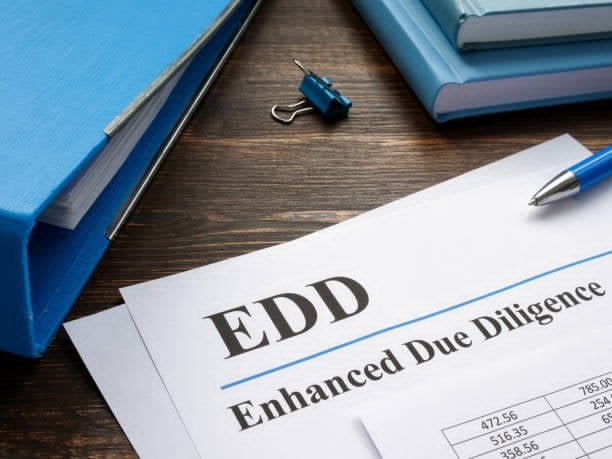EDD in AML The regulatory practices observed in today’s digital business environment call for enhanced assessment of transactional activities that may appear suspicious and show irregular patterns. These irregularities are the sole facilitator of unauthorized financial operations that leads to the exploitation of the economic operations.
Due to these reasons, various mainstream financial economies have been struck with money laundering challenges. To counter the severity of these operations, it is essential to integrate the assistance of enhanced due diligence (EDD) checks to stimulate anti-money laundering operations. EDD in AML serves a critical purpose due to its risk-based approach. To further identify the role of EDD in AML, read through the blog to understand the crucial components.
EDD and AML – The Two Most Effective Assessment Strategies Under Regulatory Bodies
EDD in AML is the procedure of assessing the risk profiles of underlying business entities and the individuals that portray risky operations. Through the integration of enhanced due diligence checks, businesses can stimulate the compliance structure of a company’s AML regulatory modules. The primary purpose of EDD in AML is to go through the transactional patterns of different entities that are conducted through a country’s financial structure.
In compliance with the EDD checks in the anti-money laundering procedures, various regulatory bodies have implemented several guidelines. The directives regarding the procedures of anti-money laundering services established by the European Union (EU) intensify the involvement of EDD checks during the recognition of illegal entities. In addition to these regulatory practices, the Basel Committee on Banking Supervision stresses the incorporation of risk management operations.
Stairway to Effective EDD Compliance Procedure
When it comes to regulating the working mechanism of the enhanced due diligence measures, it is essential to identify the important steps that streamline the identification process. An effective process of EDD in AML starts with the assessment of the client’s risk profiles, which can involve the assessment of their previous financial operations and transactional patterns. Once the risk profiles are identified, the next step is to extract the additional credentials related to the company’s beneficiaries.
EDD in AML focuses solely on eradicating money laundering practices. Therefore, the assessment of the underlying transactional activities is the cornerstone of the identification process. The EDD solutions promote the on-premise evaluation of the suspected entities, which further simplifies the identity profile assessment of the examination bodies. Businesses are required to conduct adverse media screening of potential entities to effectively investigate money laundering concerns.
Scenarios Requiring Enhanced Due Diligence Assessment
Under the regulations posed by the FATF, businesses are assisted to acquire the solutions of enhanced due diligence measures during the following mentioned scenarios:
- When a company comes across a politically exposed person or their RCAs, organizations must boost their identity evaluation measures by following the EDD requirements.
- Businesses that show irregular financial patterns and ambiguity during inter-organizational operations must pass the EDD in AML checks to authenticate their legitimacy due to their illicit operations.
- Enterprises with business relations with offshore and shell companies established in tax havens are required to involve enhanced due diligence measures to evaluate the legitimacy of the funding transactions carried out by these platforms.
EDD in Banking – Regulating Transactional Concerns
The aim of enhanced due diligence in AML checks is not just to extract the essential information but also to reduce false positive instances by complying with AML guidelines. It is, therefore, the most critical check when it comes to maintaining the banking regulations. By ensuring the involvement of ongoing AML monitoring checks, banking institutions can streamline the assessment of the company’s PEP status while countering the efforts wasted during manual client risk profile screening. An effective EDD solution guides banking institutions to define the transactional thresholds, which ultimately reduces the facilitation of illegal transactions across borders and domestically.
Suspicious Indicators Affecting Credibility of EDD Policies
According to the regulatory guidelines defined by the FATF, the companies and individuals operating from the gray list countries pose a higher level of money laundering risk to the operational jurisdiction. Any individual with a suspicious and criminal history is subjected to EDD checks as they ensure extensive analysis of their risk patterns. One of the most prominent risk indicators is when an entity associated with a sanctioned company or country tries to conduct transactions through legitimate institutions. This case must be screened extensively through EDD in AML measures to reduce the susceptible operations.
Wrapping It Up
EDD in AML is a significant approach to identifying the identity profiles of the most high-profile organizations and beneficiaries. Compliance with the anti-money laundering guidelines requires businesses to assess the suspicious transactional operations through the enhanced due diligence measures.
Once the EDD measures are incorporated into the AML screening checks, businesses can boost the effectiveness of money laundering detection. EDD in anti-money laundering checks reduces the severity of the false positive results, which enhances the credibility of the banking assessment.

